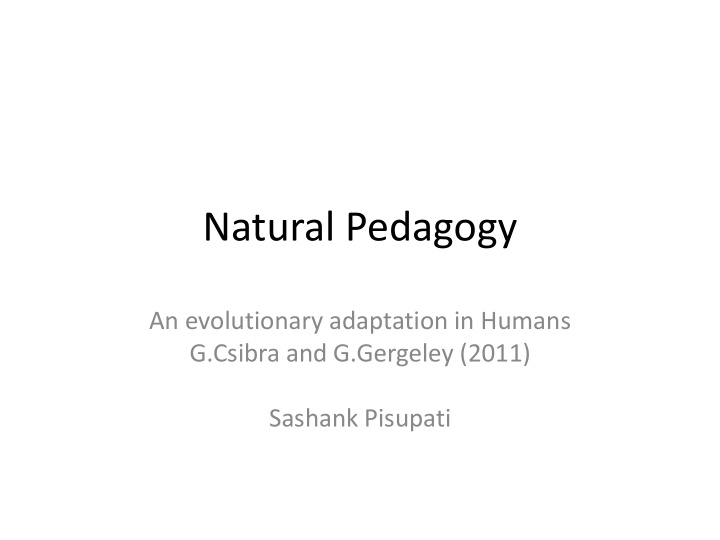



Natural Pedagogy An evolutionary adaptation in Humans G.Csibra and G.Gergeley (2011) Sashank Pisupati
What is natural pedagogy? • Communication for the purpose of teaching: cultural knowledge transmission • Specifically, directly communicating a general rule/instruction that is to be followed Eg : “ Now watch carefully son, this is how you make a fire” Communicative intent to teach intent to learn
But what is it, really? Social learning, communication and teaching do exist in the animal kingdom, but : • Social learning is usually done passively through observation, imitation or emulation – Many animals learn vocalizations from their parents through imitation: dolphins, seals, bats, songbirds, parrots – Actions and the reasons for their choice are clear • Communication is usually situation-specific eg : “Alert! Eagle overhead” • Some animals teach their offspring without explicit communication – Meerkats teach their offspring how to kill scorpions by bringing them weakened samples
The instinct to learn Babies seem to have a “ pedagogical stance ” or an instinct/willingness to learn • They are sensitive to certain cues such as direct eye contact, infant directed speech, pointing, gaze direction and gestures • In response to these directive cues, they seem to be inclined to learn and generalize rules very fast This may be the mechanism by which they pick up elements of language with very few training examples
Taking your word for it The A-not-B task: involves retrieving a toy from either container A or B after it is hidden from sight. The toy is placed repeatedly in A and then suddenly switched to B in plain sight -This classical experiment was recreated by Gergeley et.al -In the absence of any cues, they respond correctly by picking container B -But if the experimenter is visible and constantly hints/gazes at container A, they pick container A even when they know the toy was placed in B!
How does natural pedagogy help? • It allows one to communicate general rules or instructions to be learnt • It can allow someone to learn a set of actions even if the person doesn’t know exactly why that action should be performed eg.tool use Eg : “Always throw your spear in a straight line” Eg : “ Rub this log against this other log, then throw leaves onto it and blow furiously” Eg : “Toys are usually retrieved from A”
Conclusion • Natural pedagogy may have evolved when early hominin started using tools • It may have given infants a learning instinct, the ability to judge communicative intent and the ability to learn generalized rules quickly. • This may have led to the kin selection of later developments like spoken/verbal language
References • Csibra, Gergely, and György Gergely. "Natural pedagogy." Trends in cognitive sciences 13.4 (2009): 148-153. • Topál, József, et al. "Infants' perseverative search errors are induced by pragmatic misinterpretation." Science 321.5897 (2008): 1831-1834. • Hoppitt, William JE, et al. "Lessons from animal teaching." Trends in ecology & evolution 23.9 (2008): 486-493. • Fitch, W. Tecumseh. "The evolution of language: a comparative review." Biology and Philosophy 20.2 (2005): 193-203.
Recommend
More recommend